
Directions
Near Rookwood, Queensland. Take the Capricorn Highway towards Emerald, turn right about 60 kilometers from Rockhampton, just past Gogango Creek. Go through Gogango and turn right onto Riverslea Road and follow all the way to Rookwood. Rookwood homestead will be on top of the hill on your right hand side - will need to stop and speak with Eustie King to continue on his land to Goodedulla.
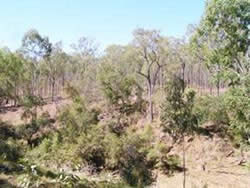 View from 20 Mile Hut Camping area |
Accessibility and Camping Availability |
Main entrance to the park is well signed, and the main road is well graded. Even the secondary roads are fairly well graded, and if not graded, there is sparse vegetation that is easily traversable. There are several camping areas, with ‘huts’ and yard areas. Twenty mile hut is the nicest accommodation, with a fire pit where wood fires can be built and there is accessible running water (probably not drinkable, unless purified). Eight mile hut could not be found, and Wadlow Yards has a tent area, not sure if it was occupied at the time, but there is also a caravan there. The camping facilities are very nice and are easily accessible. Twenty mile hut and Wadlow yards are both located near two of the main water sources in the park.
Landscape
Brigalow scrub, Python scrub, and Rosewood areas in the hills, as well as other scrub areas and tall open woodland areas. The palms area has open tall woodlands, with several gum tree species, better quality soils and water present in the small creek. The waterways (creeks) are ephemeral and seasonal, with very little water remaining during the ‘winter’ months.
Koala Presence
A koala was heard on 28 May 2006 around 10 or 10.30pm. Scratching observed on gum trees. Spoke with local landowner and there is a local man who knows of several areas where koalas occur in the park, would be good to be in contact with him, for future trips - can get details by contacting Eustie King or his wife at 4935 8573 or 0427 156 348.
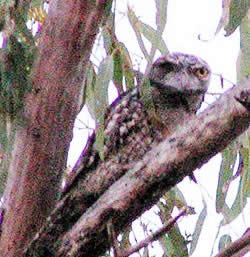 Tawny Frogmouth near Python scrub |
Other Faunal Present Ten eastern grey kangaroos, early 27 May 2006. Several gliders sighted during spotlighting. One greater glider and two squirrel gliders. Black-striped wallaby also sighted during spot lighting. Dingos heard both at night and during the early morning. Bird species that I was able to identify Pied Currawong, Sulphur-crested cockatoo, Squatter pigeon, Willie wagtail, Red winged parrot, King parrot, Laughing kookaburra, Blue winged kookaburra, Rainbow bee-eater, Tawny Frogmouth, Pale-headed rosella, Diamond dove, Red-backed fairy wren, Blue-faced honeyeater, Rufous whistler, Grey fantail, Cicada bird, Australian magpie, Double-barred finch, Wedge-tailed eagle, Black-breasted Buzzard, Australian bustard, Rainbow lorikeets and there were several other small woodland species that I am not able to identify without referencing
|
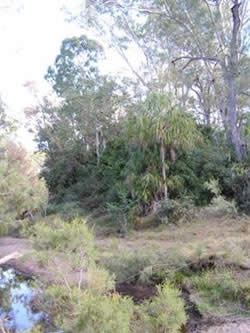 View from near Palms Creek |
|
On 1 May, the Koala Volunteers were invited to have a ‘getting to meet you’ dinner at Stephanie’s residence. We were all happy to finally meet and welcome Stephanie. We are eager to begin working with her on the research program that she has chosen.
Several field trips were discussed. Goodedulla National park was one of the first to be considered to visit, it being near to Rockhampton.
It was decided to go to there on Sat/Sun 10/11 June. Unfortunately the weather did the unthinkable and poured raining that entire weekend and we were turned back due to boggy roads.
I am sure given Stephanie’s enthusiasm we will have many enjoyable field trips in the future.
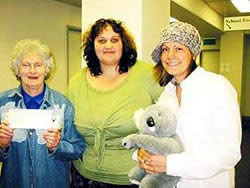 Shirley, Kerrie and Steph |
Presentation
to Research Services At the meeting on 29 May, a presentation of $5 000 was made to Kerrie Hand, Executive Officer – Research – Higher Degrees, on behalf of the CQVolunteers. This is the first of three annual payments for our PhD candidate, Stephanie Januchowski, who is being supported also by a Central Queensland University grant of $13 000 per year for three years. Shirley Hopkins |
| TOP |
Report from recent Steering Committee Meetings
10 April 2006
There were six present and three apologies.
Amount for Scholarship to be paid soon – out of ChequeA/c.
Kevin gave graphic details of trip to NZ Gully with Simon Walton – did not recommend.
Chocolates to be sold July to August – same type as 2005; boxes of shortbread could be sold nearer Christmas but Shirley would like someone else to handle those. Alistair bought a box of hats from an internet site – all approved.
Special meeting – date to be decided – with Kevin W and Steph to discuss projects and field trips.
29 May 2006
There were eight present and one apology.
Steph did a presentation of her visit to Goodedulla N.P. Alistair said the next step for Steph is to find new sites.
Alistair to visit a site near Collinsville – field trip could be organised later.
Steph wants to organise a trip to Idalia N.P.in July - will contact ranger.
Kevin W. informed meeting of his work with arboreal animals
Shirley outlined the financial statement Credit balance as at 30/04/06 . It was moved that $5 000 be paid for PhD Scholarship to CQU.
Kevin Rapley moved that we produce a minute to the effect that Alistair Melzer, Carmen Drake and Shirley Hopkins be signatories on cheques. Nick Quigley seconded the motion. It passed unanimously.
Nick told of Lauren from Gladstone who is a student very keen on environmental issues. She may be able to supply koala habitat information from the Gladstone area and on Quoin Island.
The website for CQKV: www.cqkoala.org.au There are great pictures for children to download and colour in.
Multicultural Fair – 13 August - Alistair to book site.
Display for Koala month in Northside Library – 3-17 July
Chocolate Drive – 29 & 30 July to sell Chocolates at Bunnings
Date of next meeting Monday, 10 July
As part of our plans for 2006, the Central Queensland Koala Volunteers had decided to survey a number of National Park areas where there have been reported koala sightings. This was with a view to monitoring koala populations in areas where they were discovered in any numbers, in order to identify populations that would be suitable for future research projects. One such area was a part of New Zealand Gully in the Berserker Ranges, where a number of sightings had been reported over a number of years.
A local identity, Mr. Simon Walton had agreed to show us the area so that it could be considered for this project. I was nominated to take a look, to get an idea of the lay of the land, and to consider it’s suitability for a preliminary survey. And so, on one fine Saturday afternoon in March I set out to Mr. Walton’s home, with no idea what an interesting afternoon I was about to experience.
After firstly engaging the hubs for four wheel drive, we set of into a maze of bush tracks. It became immediately apparent that without Simon’s guidance I could quite easily have not found the track we were eventually to travel up. When we did get onto the track, I soon found it to be extremely rough and extremely steep, so much so that I believe it to be some of the wildest four wheel driving I had done. Now I don’t claim any vast experience in four wheel driving, but believe me, this was not for the faint hearted!
Whilst concentrating on negotiating this wild track, I also tried to steal brief glimpses of the surrounding area. What I saw was extremely steep, very rugged and virtually impenetrable terrain. Upon getting closer to the summit, where the ground began to level out, I began to notice large rock middens scattered near the track. Upon my enquiring about these, Simon directed me to pull up and take a look. To my great astonishment I discovered that these middens were the piles of rocks that had been removed from numerous vertical shafts that had been dug through solid rock. These shafts were about three metres square (or a little less) and, according to Simon, had been hand dug by the Chinese in search for gold many years before.
Standing atop this wild, steep, impenetrable ridge I found it impossible to imagine how these people had firstly, managed to get equipment up to the area and then secondly, dug these holes, the bottoms of which were not visible, through solid rock by hand.
Upon tossing a small rock into one of these shafts, I found it to be a few second before it was heard to clatter as it struck bottom. Quite astounding!
We moved on, and found that all of the area was just as inaccessible. Whilst I was trying to concentrate on my driving negotiating very steep and rugged down hill slopes, I was forming an opinion about the suitability of this area. After probably about an hour and a half of driving, and a real test for my four wheel drive, we came back to the bottom of the ridge, some semblance of civilisation and tracks for which you did not need 4WD. Simon then showed me around a little more of the area, where country was leased to individuals and established homes were dotted throughout.
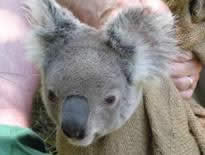 Lollipop |
After
dropping Simon off at his house and extending our thanks, I made
my way home still wondering at how hard the gold miners must have
worked, and how industrious and inventive they must have been. At
the next meeting, and after my having given a verbal report on my
findings, it was decided that the area was not suitable for our
needs and so no further action, other than a letter of thanks to
Simon, would be taken. Kev Rapley |
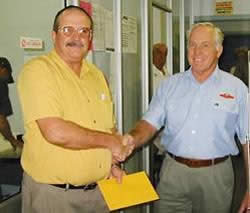 |
Congratulations to Nick Quigley who, in the recent
Queen’s Birthday Honours list, was awarded the Order of Australia
Medal. I asked him for some details of his service to the community
and I am sure you will be as interested as I was in his achievements.(Ed) |
| Nick
Quigley with Trevor Hewitt President |
He’s not one to brag, but he affirms that being awarded an OAM was one of the most incredible moments of his lifetime. A sense of huge Australian Pride! He believes he followed on from his father who gave many years to the riding for the disabled and the gymnastic club at home in New Zealand.
After Vietnam and his 2 years’ National Service and during his 28 years working with the Electricity Industry - now Ergon, he made sure there was always time that he could use to assist clubs that his son, Andrew, was involved in and SCOPE, that Helen, his wife, was part of for ten years. At the same time he took a great interest in our community but more so, the Veteran Community. One thing he can truly say is that he doesn’t have spare time but he’ll always find time for something or someone who needs assistance.
He is a Radio Amateur (call sign VK4CNQ) and he attended JOTA for 15 years providing assistance to the Scout/Girl Guide movements with the Jamboree on the Air where kids talk to other groups worldwide. At Glenmore Primary, Nick introduced the students in grade 7 to radio chat. Before the internet, with the aid of amateur radio they used satellites and repeaters to connect Little Lilies English School in India to the class room at Glenmore for live keyboard chat. While Andrew was at Glenmore Primary School, Nick spent seven years on the P & C and was a judge at the Tournament of Minds for 4 years. When Andrew moved on to High School Nick continued with the P & C at High School.
He joined the State Emergency Service in 1983 and received his 15year National Service Medal for Voluntary service in the fields of Search and Rescue, Communication and taking part in some major searches like the air search for the Banshee, Search Air Rescue at sea as a qualified Drop Master and the 1991 Floods in Rockhampton area and Longreach. The SES is a very constructive and rewarding way of serving the community.
Ever since Andrew’s primary school days the Quigley home became a Safety House and Nick developed the Safety House Queensland web site which he still maintains. Designing websites has become a very sort-after and modern way of digital advertising. After playing with webs for four years, he went to TAFE and completed Certificate 3 & 4 in Multimedia. Since then he has compiled and still maintains numerous business sites from around Rockhampton and more than 20 community groups all listed at his own website
With an interest in computers as a tool, Nick has never a dull moment. There is always something new to learn. So with that appetite he also voluntarily teaches others how to use computers to their best advantage. After a couple of years teaching at COIN, running classes himself, writing tutorial notes for students, it just goes on and on.
Within the Veteran Community Nick volunteers with the Central Queensland Veterans’ Support Centre Inc CQVSC, TPI Association, Central Queensland Military Museum, Central Queensland Vietnam Veterans’ Association, the Rockhampton Drop-in Centre and Cockscomb Veterans’ Camp.
More recently, Nick was asked to develop the Central Queensland Koala Volunteers web site, so another notch was added to the belt. He’s pleased with the site as it stands, but it needs more input from members.
Of Nick’s many and varied activities, his wife says: “In everything but the bath!”
Eucalyptus Rust from Alistair (PDF copy Available)
Below is an extract from a QLD EPA message circulated to their staff. This disease could have a big impact on all animals (eg koalas) that rely on eucalypt foliage:
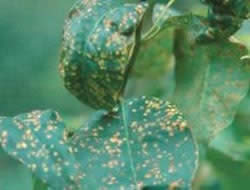 Eucalyptus Rust |
Eucalyptus Rust (also known as Guava Rust), Puccinia psidii, is a fungal pathogen which originates from Central and South America. It attacks young stems and shoots of plants in the Family Myrtaceae, forming rusty pustules which in turn produce a multitude of wind-borne spores. The pathogen is not yet in Australia but has already knocked at our door - in 2004 it was detected pre-border on wood imported from Brazil. Australian pest authorities believe there is a strong likelihood that an incursion of the pest into Australia will occur at some time. |
Eucalyptus Rust is extremely destructive to young plants, and can destroy young tissue in mature trees.
Australia has approximately half of the world’s 147 genera and 3,000 species of Myrtaceae. More Australian native plant species belong to the Myrtaceae than to any other family. Myrtaceae are dominant species in many of the major Australian ecosystems, from tall forests to swamps and wetlands. Out of 83 native Australian Myrtaceae species tested overseas for susceptibility to Eucalyptus Rust to date, 73 species show some degree of susceptibility.
For Australia, this would mean that genera such as Eucalyptus, Corymbia, Melaleuca and Syzygium may be at risk. The effect of this disease on new Australian hosts may be far more unpredictable than on hosts that have a long association with the pathogen – it is difficult to predict the impact of Eucalypt Rust on our biodiversity.
Syzygium appears to be a particularly susceptible host - even in the driest regions in Brazil, Syzygium is always attacked.
Overseas experience shows that Eucalyptus Rust spreads very rapidly – late last year it spread from one island to all of the Hawaiian Islands in just 3 months.
Alistair Melzer
Alistair Melzer made a presentation to Rockhampton Society for Growing Australian Plants on 23 June on the problem at St. Bees Is. of intrusion of rainforest vegetation into eucalypt vegetation.
Koala Web Site Report from Nick Quigley
3 Apr 2006
Our Web site is moving with the times. What we do need from members is a Bio and a photo to add to the Members’ page. Here are the site stats showing from which country visitors have come
Where visitors come from
|
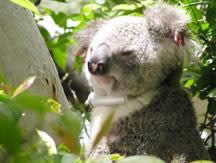 |
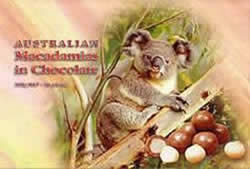 |
Elizabeth |
$6 per box |
Our current fundraiser is our gift-boxed chocolate @ $6 per box covered whole macadamia nuts; incidentally, the chocolate is Cadburys. The box is decorated with koalas see our website contact Shirley for orders
The chocolates raised $1800 in 2005
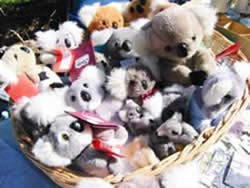 |
Carmen Drake is still gathering her orphan koalas to be sold at any stalls we may have. Carmen is also working on a pocket-sized diary featuring coloured prints of paintings done by artist friends. Hopefully, these will be on sale at the Christmas market. |
The orphans looking for new homes |
| TOP | |
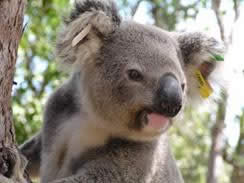 |
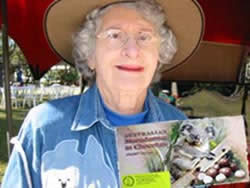 |
Xavier |
Shirley at the Fair selling the Chocolates |
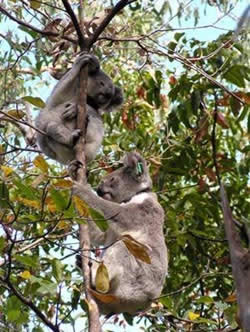 Nic and Sunshine |
What
we are doing in July July 11-16: Proposed field trip to Idalia National Park with Steph Januchowski, our PhD candidate. Will be great for volunteers to get out into the bush. Idalia NP is in the west out from Blackall. The Earthwatch trip to St Bees Island is to be led by Dr Bill Ellis from 13th to 25th July, 2006. June through
to Father's Day - We will be selling our Koala Decorated
Boxes of Macadamia Nuts covered with Cadbury Chocolate. Multicultural
Fair The volunteers will be manning a stall in the main area with information, toy orphan koalas, koala chocs and any other merchandise we may have. Help will be needed. Please let me know if you have any ideas for fund-raising. Shirley Hopkins Treasurer |